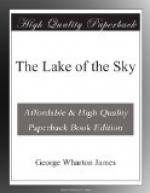Located on the Nevada side of the Tahoe region line, at the northeast end of the Lake, is Mount Rose. It is one of the most salient and important of the peaks that surround Tahoe, its elevation being 10,800 feet. The professor of Latin in the Nevada University, James E. Church, Jr., a strenuous nature-lover, a mountain-climber, gifted with robust physical and mental health, making the ascent of Mt. Whitney in March, 1905, was suddenly seized with the idea that a meteorological observatory could be established on Mt. Rose, and records of temperature, wind, snow or rain-fall taken throughout the winter months. The summit of Mt. Rose by road is approximately twenty miles in a southwesterly direction from Reno, and Professor Church and his associates deemed it near enough for week-end visits. The courage, energy and robust manliness required to carry the work along can be appreciated only by those who have gone over the ground in winter, and forms another chapter of quiet and unknown heroism in the interest of science written by so many of our younger western professors who are not content with mere academic attainment and distinction.
The idea of obtaining winter temperatures on the mountains of the Pacific Coast was first suggested by Professor McAdie, head of the Weather Bureau in San Francisco.[1] He responded to the request for instruments, and through his recommendation, thermometers, rain-gauge, etc., were speedily forthcoming from the Weather Bureau. On June 24, 1905, with “Billy” and “Randy,” family ponies, loaded with a newly designed thermometer-shelter, constructed so as to withstand winter gales and yet allow the easy exit of snow, the first advance on Mt. Rose was made.
From that day the work has been carried on with a vigor and enthusiasm that are thrilling in their inspiration. An improved instrument was added that recorded temperatures on a self-registering roll, all fluctuations, and the highest and lowest temperatures, wind-pressures, all variations in humidity, temperature, and air pressure as well as the directions and the velocity of the wind for periods of seventy days and more. This instrument was the achievement of Professor S.P. Fergusson, for many years a pioneer worker in mountain meteorology at Blue Hill Observatory and an associate of Professor Church at the Mount Rose Observatory, which has now become a part of the University of Nevada.
After two winters’ work it was discovered, on making comparisons with the records at the Central Weather Station at Reno, 6268 feet below, that frost forecast could probably be made on Mt. Rose from twenty-four to forty-eight hours in advance of the appearance of the frost in the lower levels, provided the weather current was traveling in its normal course eastward from the coast.
[Footnote 1: Since this was written Professor McAdie has been appointed to the chair of Meteorology at Harvard University.]
Second only in importance was the discovery and photographic recording of evidence of the value of timber high up on mountains, and especially on the lips of canyons, for holding the snow until late in the season.




